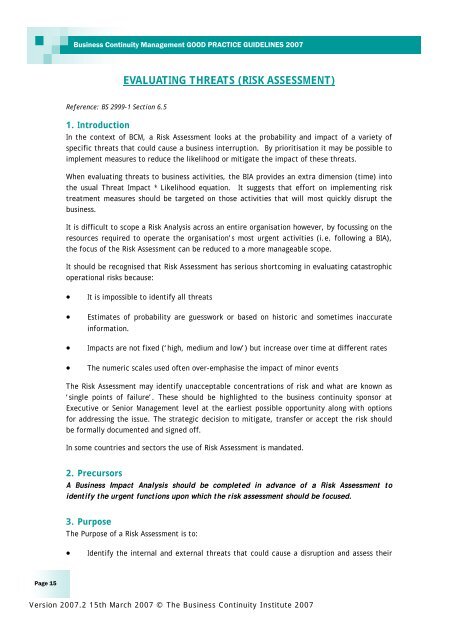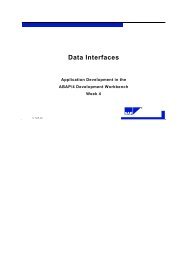business continuity institute good practice guidelines 2007
business continuity institute good practice guidelines 2007
business continuity institute good practice guidelines 2007
Create successful ePaper yourself
Turn your PDF publications into a flip-book with our unique Google optimized e-Paper software.
Page 15<br />
Business Continuity Management GOOD PRACTICE GUIDELINES <strong>2007</strong><br />
Reference: BS 2999-1 Section 6.5<br />
1. Introduction<br />
EVALUATING THREATS (RISK ASSESSMENT)<br />
In the context of BCM, a Risk Assessment looks at the probability and impact of a variety of<br />
specific threats that could cause a <strong>business</strong> interruption. By prioritisation it may be possible to<br />
implement measures to reduce the likelihood or mitigate the impact of these threats.<br />
When evaluating threats to <strong>business</strong> activities, the BIA provides an extra dimension (time) into<br />
the usual Threat Impact * Likelihood equation. It suggests that effort on implementing risk<br />
treatment measures should be targeted on those activities that will most quickly disrupt the<br />
<strong>business</strong>.<br />
It is difficult to scope a Risk Analysis across an entire organisation however, by focussing on the<br />
resources required to operate the organisation’s most urgent activities (i.e. following a BIA),<br />
the focus of the Risk Assessment can be reduced to a more manageable scope.<br />
It should be recognised that Risk Assessment has serious shortcoming in evaluating catastrophic<br />
operational risks because:<br />
• It is impossible to identify all threats<br />
• Estimates of probability are guesswork or based on historic and sometimes inaccurate<br />
information.<br />
• Impacts are not fixed (‘high, medium and low’) but increase over time at different rates<br />
• The numeric scales used often over-emphasise the impact of minor events<br />
The Risk Assessment may identify unacceptable concentrations of risk and what are known as<br />
‘single points of failure’. These should be highlighted to the <strong>business</strong> <strong>continuity</strong> sponsor at<br />
Executive or Senior Management level at the earliest possible opportunity along with options<br />
for addressing the issue. The strategic decision to mitigate, transfer or accept the risk should<br />
be formally documented and signed off.<br />
In some countries and sectors the use of Risk Assessment is mandated.<br />
2. Precursors<br />
A Business Impact Analysis should be completed in advance of a Risk Assessment to<br />
identify the urgent functions upon which the risk assessment should be focused.<br />
3. Purpose<br />
The Purpose of a Risk Assessment is to:<br />
• Identify the internal and external threats that could cause a disruption and assess their<br />
Version <strong>2007</strong>.2 15th March <strong>2007</strong> © The Business Continuity Institute <strong>2007</strong>
















